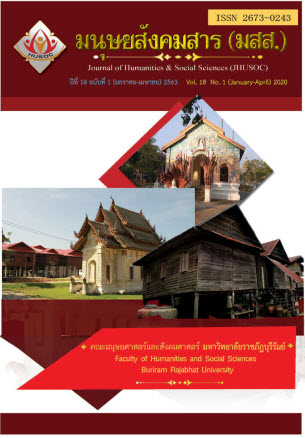การศึกษาการเรียนรู้ด้วยตนเองของคนรุ่น Z กรณีศึกษา วิทยาลัยนานาชาติ มหาวิทยาลัยนเรศวร
Main Article Content
บทคัดย่อ
Nowadays the characteristics of the new generation of students are not the same as previous generations, and also the ways they learn things have obviously changed due to the advancement of technology, especially for “Generation Z”,who has been surrounded with technology and digital devices all their lives. Modern education involves students in self-directed learning, which can also be conducted with the advancement of technology in order to continuously improve their skills to be successful in the competitive globalized labor market.
The objective of this research was to find out the self-learning methods of Generation Zers that they would prefer to take in order to develop and prepare themselves to be successful in the aforementioned market. The population and samples of this research were 115 Generation Z students from different majors of Naresuan International College. The instrument used in this study was rating-scale. The statistical values were the frequency, percentage, mean, standard deviation and content analysis. The study revealed the interest of the Generation Zers in self-directed learning methods that they were interested in taking to develop their skills, namely and in order of interest: online learning, online videos, websites, attending training seminars, and having guest speakers.
Article Details
เนื้อหาและข้อมูลในบทความที่ลงตีพิมพ์ในวารสารทดสอบระบบ ThaiJo2 ถือเป็นข้อคิดเห็นและความรับผิดชอบของผู้เขียนบทความโดยตรงซึ่งกองบรรณาธิการวารสาร ไม่จำเป็นต้องเห็นด้วย หรือร่วมรับผิดชอบใดๆ
บทความ ข้อมูล เนื้อหา รูปภาพ ฯลฯ ที่ได้รับการตีพิมพ์ในวารสารทดสอบระบบ ThaiJo2 ถือเป็นลิขสิทธิ์ของวารสารทดสอบระบบ ThaiJo2 หากบุคคลหรือหน่วยงานใดต้องการนำทั้งหมดหรือส่วนหนึ่งส่วนใดไปเผยแพร่ต่อหรือเพื่อกระทำการใดๆ จะต้องได้รับอนุญาตเป็นลายลักอักษรจากวารสารทดสอบระบบ ThaiJo2 ก่อนเท่านั้น
เอกสารอ้างอิง
Brockett, R.G., Hiemstra, R. (1991). Self-Direction in Adult Learning. Perspectives on theory, research and
practice, London: Routledge, 276.
Brue Tulgan & Rain Maker Thinkign Inc. (2013). Meet Generation Z: The second generation within the giant
"Millennial" cohort Rerieved from https://rainmakerthinking.com/assets/uploads/2013/10/Gen-Z
Whitepaper.pdf.
Friedman, T. L. (2005). The world is flat: A brief history of the twenty-first century. New York, NY, US: Farrar,
Straus and Giroux.
Generational White Paper. (2011). Generation Z and the Career Strategist Retrieved from
https://www.workcomms.com/graduates/whitepapers/Generation-Z/
Gerke, M. L., (2001). Understanding and leading the quad matrix: Four generations in the workplace: The
traditional generation, Boomers, Gen-X, and the Nexters. Seminars for Nurse Mangers. 2001; 9(3):
-181.
Guglielmino, L. M., & Long, H. B. (2011). Perspectives: The international society for self-directed learning and the
international self-directed learning symposium. International Journal of Self-Directed Learning,
(1), 1-6.
Hahn, J. A. (2011). Managing multiple generations: Scenarios from the workplace. Nursing Forum. 2011; 46(3):
-127.
Hampton, D., Keys, Y. (2016). Generation Z: Now Entering our Work Settings. Voice of Nursing Leadership. 2016;
(4): 14-16.
Heinrich, W. F., Habron, G.B., Johnson, H.L., & Goralnik, L. (2015). Critical Thinking Assessment across Four
Sustainability-Related Experiential Learning Settings. Journal of Experiential Education, 38(4) 373-
Hiemstra, R. (1994). Self-directed learning. In T. Husen & T. N. Postlethwaite (Eds.), The International
Encyclopedia of Education (second edition), Oxford: Pergamon Press. Reprinted here by permission.
Hodge, K.A. and Lear, J.L., (2011). Employment Skills for 21st Century Workplace: The Gap Between Faculty and
Student Perceptions. Journal of Career and Technical Education, 26(2).
Humphreys, D. (2013). Employers More Interested in Critical Thinking and Problem Solving Than College Major.
Retrieved from: www.aacu.org (https://www.aacu.org/)
Jones, V., Jo, J., Martin, P., (2007). Future Schools and How Technology can be used to support Millennial and
Generation-Z Students. In ICUT 2007 (Proc. B), 1st Int. Conf. Ubiquitous Technology.2007.12-14.
Joseph Coombs. (2013). Generation Z: Why HR Must Be Prepared for Its Arrival Retrieved from
https://www.shrm.org/hrdisciplines/staffingmanagement/articles/pages/preparefor generation-z.aspx
Knowles, M. (1975). Self-Self-Directed Learning. A Guide for Learners and Teachers. Englewood Cliffs: Prentice
Hall/Cambridge.
Kupperschmidt, B.R. (2000). Multigeneration Employees: Strategies for Effective Management. Health Care
Manager, 19(1), 65–76. DOI: 10.1097/00126450200019010-00011.
London, M., & Smither, J. W. (1999). Career-related continuous learning: Defining the construct and mapping the
process. In G. R. Ferris (Ed.), Research in human resources management, Vol. 17, pp. 81-121.
McCrindle, M. (2016). Generation Z characteristics. Retrieved on 7 May, 2008 from website:
https://generationz.com.au/characteristics/
Moore, M., Sewart, D., Keegan., Homberge, B. E. (1984). On a theory of independent study. Distance education:
International perspectives (pp.68-94). London: Rougtledge.
Naomi R. Boyer, Sarah L., Alessio G. (2008). Self Direction and Constructivism in Programming Education.
University of South Florida Polytechnic USA.
NCREL & Metiri Group. (2003). enGauge 21st century skills: Literacy in the digital age. Rerieved from
https://www.ncrel.org/engauge.org/engauge [1 April 2012].
Pedler, M., Burgoyne, J. and Boydell, T. (2007). A manager’s guide to self development. 5th edn. Maidenhead,
Berks: McGraw-Hill.
Postolov, K., Magdiceva, S. M., Janeska, I. A.: (2017). E-Learning in the Hand of Generation Y and Z. Proceedings of
the intonation Conference “Business & Entrepreneurial Economics-BEE2017”
Renfro, A. (2012). Meet generation Z. Gettingsmart.com. Retrieved on 2 May, 2018 from
https://gettingsmart.com/2012/12/meet-generation-z./.
Robinson, S. J. & Garton, B. L. (2007). An assessment of the employability skills needed by College of Agriculture,
Food and Natural Resources graduates at the University of Missouri-Columbia. Proceedings of
the 2007 AAAE Research Conference, 34, 385-401.
Sagitova, R. (2014). Students’ Self-Education: Learning to Learn across the Lifespan. Procedia So-cial and
Behavioral Sciences, 152, 272-277. https://dx.doi.org/10.1016/j.sbspro.2014.09.194
Seemiller, C., Grace, M. (2016). Generation Z Goes to College. San Francisco, California: Jossey Bass.
Serdyukov, P., Robyn A. H. (2013). Flying with Clipped Wings: Are Students Independent in Online College
Classes? Journal of Research in Innovative Teaching, 6(1), 53-65.
Sidorcuka, I., & Chesnovicka, A. (2017). Methods of attraction and retention of generation z staff. CBU
International Conference on Innovations in Science and Education. 2017. 22-24
Sigh, A. P., Deangmei, J. (2016). “Understanding the generation z: the future workforce”, South-Asian Journal of
Multidisciplinary Studies. Vol. 3 Issue 3
Teresa Bridge. (2015). 5 Ways The workplace Needs To Change to Get The Most out of Generation Z. Retrieved
from https://www.fastcoexist.com/3049848/5-ways-the-workplaceneeds-to-change-to-get-the-
most-out-of-generation-z


